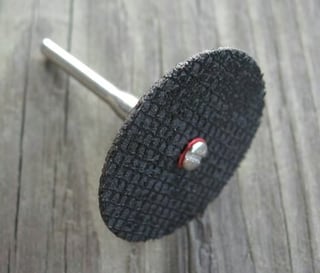The Dremel style tool with an abrasive cutting disc is your best option. These come in a couple different sizes and durability options.

Dremel disks
I go for the smaller, heavy duty disks. These are usually the darker color ones, like the one pictured. The red ones tend to be the "light duty" style and will tend to crack just installing them. The dark ones can crack when installing, but not as easily.
Using the smaller diameter disc will help prevent vibration and other problems, just take it slow and with deliberation. Just like with almost any power tool, you don't want to start the motor with the disk touching the material, and approaching the material slowly will help prevent any vibrations due to the shock of touching the spinning wheel.
These disks can also be used to file off any burrs as well as just generally rounding off the exposed end of the screw. Doing this will help fix the threads so the screw will be able to be removed, eventually. These disks are also thin and easily maneuverable. Being thin will help prevent vibration.
Also, there's likely a speed setting that'll help prevent vibration. Too high of speed and you won't be able to keep the disk on the screw, causing vibration. Too slow and all you'll be doing is vibrating the device.
The large diameter disks are nice, but they are 2-3 times thicker and much harder to control in tight spaces, as well as with small parts. They are great for larger cutting things, but as tiny a screw as you're talking about, it' not appropriate.
Hand tools
A hand saw would need very fine teeth to prevent vibrating, and you won't be able to control it as easy as the Dremel tool. The thing with a hand saw is that you sacrifice speed for control. You can have all kinds of control, but it's going to take you at least 10 times as long to cut through the piece.
Also, you'll still need to file off the burr and fix the threads. Using a hand file has the same problems as the Dremel and the hand saw. Too fast and you create vibration, too slow and all you're doing is vibrating the material. Too fast and you lose control, too slow and you're just vibrating the material.


